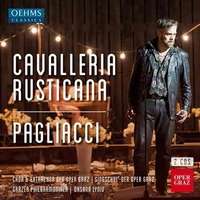|
Back
02/27/2020
Pietro Mascagni: Cavalleria rusticana
Ruggiero Leoncavallo: Pagliacci
Cavalleria rusticana: Ezgi Kutlu (Santuzza), Aldo Di Toro (Turiddu), Audun Iverson (Alfio), Mareike Jankowski (Lola), Cheryl Studer (Lucia)
Pagliacci: Aurelia Florian (Nedda), Aldo Di Toro (Canio), Audun Iverson (Tonio), Martin Fournier (Beppe), Neven Crnic (Silvio)
Chor and Extrachor, Singschul Oper Graz, Bernhard Schneider (chorus master), Oksana Lyniv (conductor)
Recording: Opera Graz, Austria (2018-2019) – 143’84
2 CDs Oehms Classics OC987 (Distributed by Naxos of America)

   
I have the impression that the impetuous twins Cavalleria rusticana and Pagliacci are slowly losing their place in the core operatic repertoire. In the dramatic arts irony is always considered to be cleverer or more sophisticated than sincerity, and both these operas deal with basic, visceral emotions: heartfelt love, implacable hatred, harsh vengeance. All this plus vivid dramatis personae, and each plot compacted into less than 75 minutes.
Cavalleria rusticana premiered in Rome, in 1890 and Pagliacci followed two years later in Milan (conducted by Arturo Toscanini no less), and both were a great success from the start. There are numerous recordings featuring many of the most noted singers since the invention of recorded sound. If the singers on this issue are not widely known it might be that they are on the way up. Most important of all is the conductor, Oksana Lyniv, who has an increasingly high international profile; the energy and commitment displayed on this recording help explain why. She brings out the scores’ contrasts: for example, the yearning quality in the Prelude to Cavalleria rusticana gives way to the foretaste of the drama to follow. At one point the Easter procession is taken, perhaps, a bit too broadly for the comfort of the Santuzza. It’s Ezgi Kutlu who, overall, has the spinto voice the role demands.
The plots: in Cavalleria rusticana a carefree young man, Turiddu, has been wooing a young woman, Santuzza. Unknown to him she is pregnant with his child which means she is excommunicated. He has also been dallying with an old flame, Lola, when her husband, Alfio, is away. Santuzza implores Turiddu to return to her, and when he spurns her, she curses him. Alfio comes by and in her fury she tells him about his wife’s affair. Alfio challenges Turiddu to a duel and Turiddu is killed. It all takes place in front of a church on Easter Sunday morning. “Santuzza" is a diminutive of Santa (“saint”) and “Turiddu” of “Salvador” (saviour). And it all happens at Easter - perhaps there is deep irony after all.
Pagliacci is set amongst an itinerant commedia dell’arte troupe led by Canio who is married to Nedda. Another member of the troupe, Tonio, lusts after Nedda but she spurns him. However, Tonio is aware she is having an affair with a man, Silvio, from the town, and he informs her husband. In front of a village audience the troupe performs its stock comedy which involves a woman, Columbina (portrayed by Nedda), who is betraying her husband Pagliaccio (portrayed by Canio). The plot of the comedy hits too close to home for Canio who goes berserk and stabs both Nedda and Silvio. “La commedia é finita” is the famous final line.
The singers involved are all well chosen. Tenor Aldo Di Toro is both the doomed Turiddu and the frenzied Canio; it must have been quite an evening’s work to perform both, but he has the right voice and heartfelt vigour. Santuzza is Turkish mezzo-soprano Ezgi Kutlu who brings warmth to her character’s yearning, anguish, fury, and remorse.
Nedda is rather a more lyric role, and Romanian soprano Aurelia Florian shines - performing, for rxample, her difficult paean to the songbirds “Oh! che volo d’augeli” with aplomb.
Baritone Audun Iversen compellingly portrays the macho Alfio in Cavalleria; the conductor thrillingly escalates the tension at the end of his scene with Santuzza. He is then the vindictive Tonio in Pagliacci, a role that also allows him to present a tender side in its prologue. This is sung very nicely (it seems to me that it always is).
Smaller roles are also well done, such as Martin Fournier as the trouper Beppe who sings a pleasant little serenade to “Columbina”. Ably performing the mezzo role of Turiddu’s perplexed mother, Lucia, is none other than Cheryl Studer whose career soared through a lengthy starry phase in lead soprano roles.
This recording is of a production that was performed 13 times at the Graz Opera from September 2018 to June 2019. If the recording is from live performance(s) there is no discernable stage noise or applause (which would have been well-earned). Everyone seems totally immersed in the verismo style.
A note on the download release: Cavalleria rusticana is released on 16 tracks which reflects the divisions within the opera itself thanks to its singular composition history: it had to be composed quickly to meet a deadline, and the librettists lived some distance from where Mascagni lived, so they mailed the libretto in fragments on postcards and Mascagni composed each bit as it arrived. The 16 tracks do not unduly break the flow, but there are minor glitches in that tracks number one, six, and nine are ended just a second or so too soon; thus, for example, the final chord of the prelude is truncated and its last note is heard at the start of track two.
Pagliacci is more through-composed. After the Prelude, Act I Is divided into three scenes, but on this issue, Scene I is divided into six tracks, Scene II into two, and Scene III into six. Following the Intermezzo, Act II contains just the opening four-minute scene, then Scene II is about 19 minutes long for la commedia, the play within a play that hurtles to the tragic dénouement. Unfortunately this is chopped into six tracks. Overall there are 23 tracks, some shorter than two minutes; this is a serious impediment to experiencing to the work as intended. Listening to the CD is easily the preferable option.
Michael Johnson
|